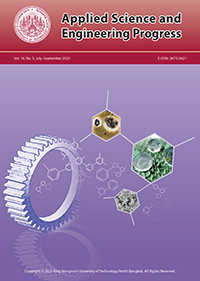Experimental Study and Analysis of Fretting Wear and its Influence on Functionality of Mechanical Components
Main Article Content
Abstract
Fretting occurs when there is tangentially low-amplitude vibrational motion (range tens of nanometres to tens of micrometers) between nominally stationary contact surfaces. This is a common occurrence as most machines are exposed to vibration both in transit and in operation. Contacts that appear to have no relative movement, such as press-fit, can actually slide on a scale of 1 μm with alternating pendulum loads. It is very difficult to eliminate such movements and the resulting friction. Fretting wear and frictional fatigue occur on almost every machine and otherwise cause a total failure of robust components. Studies have shown that, in contrast to other forms of wear, the frequency of machine fit problems has not diminished in the last few decades. Experiments were conducted on a fretting wear testing machine of amplitude range 10–200 μm, frequency range 4–120 Hz and surface roughness were recorded for both polished and unpolished condition. The correlation was made between changing parameters and variation in surface roughness. Friction fatigue is an important but almost unknown factor when load-bearing components are damaged at very low loads. Therefore, we will conduct an experimental study of fretting and its control parameters. For unpolished specimen, the variation of amplitude with respect to the coefficient of friction (COF) increases to 0.5, then it becomes linear. For semi-polished specimen, it increases to COF 0.45 and then it starts decreasing. For a fully polished specimen, there is no change in COF to 75 μm and then it starts increasing. According to the experimental data, for all specimens’ COF constantly decrease with increasing the load.
Article Details
References
T. Yue and M. A. Wahab, “A review on fretting wear mechanisms, models and numerical analyses,” Computers, Materials & Continua, vol. 59, no. 2, pp. 405–432, 2019, doi: 10.32604/cmc. 2019.04253.
I. R. McColl, J. Ding, and S. B. Leen, “Finite element simulation and experimental validation of fretting wear,” Wear, vol. 256, no. 11–12, pp. 1114–1127, 2004, doi: 10.1016/j.wear. 2003.07.001.
R. B. Waterhouse, Fretting Fatigue. London: Applied Science, 1981.
R. B. Waterhouse, Fretting Wear. Ohio: ASM International, 1992, pp. 233–256.
Z. R. Zhou and L. Vincent, “Cracking induced by fretting of aluminium alloys,” Journal of Tribology, vol. 119, no. 1, pp. 36–42, 1997, doi: 10.1115/1.2832477.
M. H. Zhu, Z. R. Zhou, P. Kapsa, and L. Vincent, “An experimental investigation on composite fretting mode,” Tribology International, vol. 34, no. 11, pp. 733–738, 2001.
M. H. Zhu and Z. R. Zhou, “An experimental study on radial fretting behaviour,” Tribology International, vol. 34, no. 5, pp. 321–326, 2001.
Z. Cai, M. Zhu, and Z. Zhou. “An experimental study torsional fretting behaviors of LZ50 steel,” Tribology International, vol. 43, no. 1–2, pp. 361–369, 2010.
J. L. Mo, M. H. Zhu, J. F. Zheng, J. Luo, and Z. R. Zhou, “Study on rotational fretting wear of 7075 aluminum alloy,” Tribology International, vol. 43, no. 5–6, pp. 912–917, 2010.
Z. R. Zhou and L. Vincent, “Effect of external loading on wear maps of aluminium alloys,” Wear, vol. 162, pp. 619–623, 1993.
Z. R. Zhou and L. Vincent, “Mixed fretting regime” Wear, vol. 181–183, pp. 531–536, 1995.
Z.R. Zhou, S. Fayeulle, and L. Vincent “Cracking behaviour of various aluminium alloys during fretting wear,” Wear, vol. 155, pp. 317–330, 1992.
M. H. Zhu and Z. R. Zhou, “On the mechanisms of various fretting wear modes,” Tribology International, vol. 44, no. 11, pp. 1378–1388, 2011.
J. F. Zheng, J. Luo, J. L. Mo, J. F. Peng, X. S. Jin, and M. H. Zhu, “Fretting wear behaviors of a railway axle steel,” Tribology International, vol. 43, no. 5–6, pp. 906–911, 2010.
R. D. Mindlin, “Compliance of elastic bodies in contact,” Journal of Applied Mechanics, vol. 16, no. 3, pp. 259–268, 1949.
O. Vingsbo and S. Söderberg, “On fretting maps,” Wear, vol. 126, no. 2, pp. 131–147, 1988.
P. Kapsa and L. Vincent, “Progress in fretting maps” Tribology International, vol. 39, no. 10, pp. 1068–1073, 2006.
M. H. Zhu, H. Y. Yu, Z. B. Cai, and Z. R. Zhou “Radial fretting behaviors of dental feldspathic ceramics against different counter bodies,” Wear, vol. 259, no. 7–12, pp. 996–1004, 2005.
M. H. Zhu, H. Y. Yu, and Z. R. Zhou “Radial fretting behaviors of dental ceramics,” Tribology International, vol. 39, no. 10, pp. 1255–1261, 2006.
K. L. Johnson, Contact Mechanics. Great Britain, UK: Cambridge University Press, 1985.
Z. B. Cai, M. H. Zhu, J. F. Zheng, X. S. Jin, and Z. R. Zhou, “Torsional fretting behaviors of LZ50 steel in air and nitrogen” International Tribology, vol. 42, no. 11–12, pp. 1676–1683, 2009.


